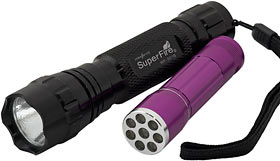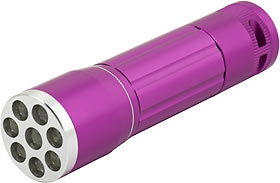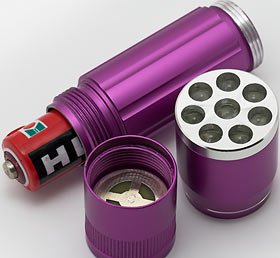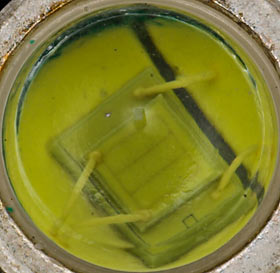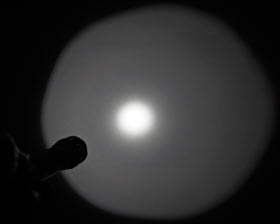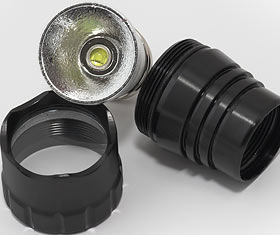
Ultrafire WF-501B and Xnova LED flashlights
Review date: 13 October 2007 Last modified 03-Dec-2011.
When LED flashlights with better than penlight brightness were new, the only way manufacturers - or hackers - could get that kind of brightness was by using an array of many 5mm LEDs.
Flashlights like that are still around. EBay dealers seem to be trying to one-up each other on the sheer number of LEDs they can cram into the front of a flashlight.
But array lights are old technology now. Today, we have single giant LEDs, which started out with roughly one-watt power ratings (versus a ceiling power of about 0.1 watts for 5mm LEDs). Super-LEDs started out with watts-to-photons efficiency not much better than a halogen bulb, but they've been improving ever since. They've always had functionally infinite lifespans for flashlight use, if they're not horribly overdriven. And they also let people make LED flashlights with a good focussed beam, without having to give each LED in an array its own lens.
Super-LEDs weren't cheap when they were new. You could easily spend more than $US100 on a nice pocket light with an early Luxeon Star one-watt LED in it.
Now, though, eBay's full of cheap flashlights with "super-LEDs" in them. These LEDs, at the moment mostly from Cree or Seoul Semiconductor, often have about a three-watt rating, and produce quite a lot more light per watt than the early super-LEDs did.
Those high price tags are a thing of the past, too. $US25 or so buys you one of the new breed of LED light - and that even includes delivery from the dealers, who're usually in Hong Kong.
The higher-powered lights often use some kind of lithium battery - either non-rechargeable CR123 cells, or rechargeable lithium ion 123s or larger 18650 cells. Lithium batteries of all sorts also used to be pretty exotic technology, but they aren't any more. Both rechargeable and non-rechargeable lithium batteries are, you guessed it, all over eBay, for rock-bottom prices.
These new cheap lights don't, of course, carry any brand that any normal person's ever heard of. "Ultrafire" and "Superfire" are popular flavours of cheap CR123 flashlight at the moment. They're both actually the same flavour, really; the two names are printed on the exact same actual products, and I presume "Megafire" and "Gigafire" are waiting to be used. The actual name of the manufacturing company appears to be "HWA/WYS".
The Whateverfire names are all plays on SureFire, who've been making expensive but bulletproof CR123-powered "tactical" lights since well before the LED era.
(I, by the way, stand by my previously expressed opinion that what the adjective "tactical" usually means is "black".)
The question, of course, is whether a cheap Chinese light with a brand name that sounds a bit like a much more famous one is, actually, any good.
So I was pleased when the proprietors of Shenzhen LED Flashlight contacted me to arrange a review.
Never mind the quality, feel the price!
Shenzhen LED Flashlight's deal is simple enough. They sell the same stuff you can get on eBay, but from a conventional Web store and at even lower prices than many eBay dealers.
The szwholesale.com site is, as you might have guessed, their wholesale outlet. It charges extra if you're buying less than $US200 worth of stuff. But szwholesale.com doesn't charge anything for shipping or handling, if your order exceeds $US200.
If the flashlights they sell are any good at all, this relatively low order value threshold could offer a quick way to get all of your Christmas shopping done in ten minutes.
If you're not quite ready for that level of commitment, the same company has a retail site, called Quality China Goods.
With a name like that, they've got to be... called Quality China Goods!
Everything on the Quality China Goods site costs more than it does on the wholesale site. But the prices once again include shipping to anywhere in the world.
(There are also some stock differences - the wholesale and retail sites each sell a variety of non-flashlight gadgets, but not everything is available on both sites.)
Aaanyway, they sent me two flashlights to play with.
The little purple one is a cheap and cheerful 5mm-array light, with eight LEDs powered by a simple single AA battery. The bigger black one is an Ultrafire WF-501B.
First, the little one.
Purple power
This flashlight costs only $US6.19 delivered from Quality China Goods (with quantity discounts if you buy as few as two), or a lousy $US3.59 from the wholesale site, where you'd have to buy 56 of 'em to cross the $US200 line.
It's allegedly an "Xnova" product. The famous flashlight brand being imitated this time is Inova, one of whose quirkier 5mm-array lights I reviewed years ago.
The little Xnova is about 83mm (3.3 inches) long and about 22.5mm (0.9 inches) wide at its lamp end, and its body is made from lightweight aluminium. So it's a pretty easy light to carry around in your pocket.
And because this little light has eight 5mm LEDs and runs from a single AA cell, it promises to be bright enough for everyday pocket-light use, and usable from easy-to-find and inexpensive batteries.
The light has three parts - lamp, tube and tailcap. The on/off switching mechanism depends on a somewhat mysterious combination of how far the head and tail are screwed on. It's easy enough to do, but I haven't been able to figure out exactly where the circuit breaks when you tighten the lamp end down all the way.
However it works, it's a bit on the dodgy side. Turn the light on and off over and over and you're likely to get noticeably different brightness from one cycle to the next. It doesn't flicker when on and you don't have to hit it to make it work, though, so by the standards of very cheap flashlights, it'll do.
Most LED flashlights with turn-the-end switches have rubber O-rings to seal the threaded parts against water. The Xnova doesn't. In ordinary use this is unlikely to be a problem - only if the light's actually submerged in water will any be likely to get in, and it's easy to take the light apart to dry it out.
The Xnova throws the same smooth and fuzzy circle of light as every other 5mm-array flashlight, with a beam width of roughly 20 degrees. When it feels like running at full brightness, you get about 38 lux at one metre from the middle of the beam. That's more than bright enough for night-time walking-around purposes, but you're not going to be spotting any possums in the trees.
And, remember, this flashlight is powered by a single AA cell. You just can't wring much juice out of an alkaline AA - although quite a few current lights try, and get lousy battery life as a result.
The flashlight I own that's most similar to the 8-LED Xnova is the little 7-LED Peak LED Solutions "McKinley" light that I reviewed here, back in 2004. Comparing it with the newer, much cheaper light is instructive.
The McKinley (still available in an updated version here) is powered by a CR123 lithium cell, which can deliver a lot more juice at a nominal three volts than an AA can at its nominal 1.5V. But it's got one fewer LED than the Xnova, and its LEDs are 2004-vintage.
At one metre, running from a not-too-young battery, the McKinley delivered a healthy 85 lux at one metre, with about the same beam width as the Xnova.
I thought this indicated either some crummy Chinese knock-off LEDs in the Xnova lamp or a poor electronic design... until I measured the Xnova's power consumption.
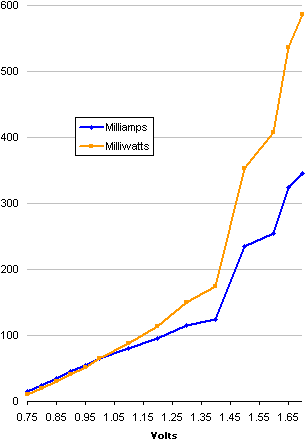
The voltage figures here are pretty accurate, because they come from a multimeter across the lamp, not just from the display on the front of the variable bench power supply I used to drive it.
The current figures are from the power supply's display, though, so I wouldn't bet my life on them. They're close enough for government work.
This graph says two things.
One: The cheap Xnova does not have the kind of clever regulating hardware that causes it to consume about the same power over a range of supply voltages.
That's probably a good thing in this case, though, because it means the flashlight's batteries will last longer.
A more aggressive regulator keeps the lamp power steady by drawing more current as the battery voltage drops. That means more minutes of high brightness, but less overall battery life.
The Xnova's regulator will give you dimmer light if you decide to run the flashlight from a (1.2 volt) NiMH or NiCd cell rather than from an alkaline (1.5V) or lithium (1.7V) AA. But the trade-off is that this flashlight will actually also run quite well from dirt cheap carbon-zinc AAs, which die very quickly if you use them in a high load device. A battery isn't included with the retail Xnovas, but my review light came with the single dodgiest-looking off-brand carbon-zinc AA I've ever seen in my life. That battery worked just fine.
I tried a brand-name alkaline during the brightness testing; it made no difference at all.
LED flashlights that have a "dumb" resistor-based design are famous for letting you use every last skerrick of battery power, as long as you're happy with a fraction of their fresh-battery brightness. The voltage-versus-current graph shows that the Xnova is the same. Its last gasp of brightness is way down at less than 0.75 volts, below the 0.8V line that's often used as the definition of functional flatness in 1.5V-nominal batteries.
The second thing the power graph says is that the LEDs in this flashlight are good Chinese knock-offs.
Yes, my old Peak LED Solutions McKinley is more than twice as bright as the Xnova, but the McKinley's lamp draws about half an amp from its three-volt battery - 1.5 watts. So it may be more than twice as bright, but it draws four times as much power. From a fresh alkaline, the Xnova will only draw about 0.35 watts.
(From a fresh lithium AA, you'll get almost 0.6 watts; that's probably not high enough to be doing the LEDs any harm. Note that rechargeable AA-sized lithium batteries also exist, but they're 3.6-volt-nominal devices which are not usable in devices that expect 1.5V-nominal cells. One of them would probably kill the Xnova's lamp in seconds.)
I bet the current Peak LED Solutions McKinley flashlights have newer, higher efficiency LEDs and thus perform much better. But, for the meagre power the Xnova lamp consumes, it does a decent job.
On to the Ultrafire.
Submachine gun not included
The Ultrafire WF-501B follows the standard pattern for small "tactical" flashlights. Black (of course!), tough looking aluminium body, clicky switch on the tailcap (you're meant to hold the light in your fist and press the button with your thumb). It's just small enough to fit, somewhat uncomfortably, in a front pants pocket.
The Ultrafire's clicky switch is the kind you normally get on cheap flashlights. You have to click the switch to turn the light on, and you can't just push it partially down to turn the light on momentarily.
This is fine for most purposes, but people who actually do want to use a flashlight "tactically" prefer a switch that has momentary action too.
The 501B also doesn't have an anti-roll design. The end cap has some token grooves that very slightly impede its rolling progress, but that's all. Again, proper "tactical" lights are different; they're usually shaped so that they'll stay put when you put them on a gently sloped surface.
The scalloped profile of the lamp end of the 501B, however, is awfully "tactical". It has two functions.
One, it lets light out even if the flashlight's standing face down on a table, so you can tell if you've left it on by accident.
And two, it makes it hurt more when if you decide to hit someone
with the light.
The WF-501B's only a bit more than 13 centimetres long, and only weighs about 125 grams (4.4 ounces) with batteries. So you're not going to be using it as a nightstick. But you still wouldn't want to get Kubotanated with this thing.
The 501B feels good in the hand. The grip knurling is sharp enough to be useful, but smooth enough to be comfortable. All of the threads are well cut and O-ring sealed. There's even a glass lens on the front of the lamp, instead of less-transparent plastic.
There's a very cheap version of the 501B that comes with a filament bulb, but its only advantage besides price is that it's got an adjustable beam width. And it's not as if it's that much cheaper; this LED WF-501B costs only $US23.99 including delivery.
From the wholesale site, it's a mere $US20.99.
You can run the LED 501B from three possible battery combinations.
Simplest and cheapest - in the short term, anyway - is a pair of CR123A lithiums. CR123s will probably cost you a small fortune if you buy them at the supermarket, but they're dirt cheap from specialist dealers. Quality China Goods has off-brand versions for $4.23 a pair delivered, or only $2.11 a pair if you buy ten pairs. SureFire-branded batteries cost a bit more, and card-packed Panasonics cost a lot more.
Buying 123s in bulk is not a bad idea, since lithium batteries last approximately forever on the shelf; their usually stated shelf life is ten years, but they should still have plenty of charge left even then.
The 501B can also run from a pair of rechargeable CR123s. Four "protected" rechargeable 123s and a charger will set you back $US28.49 delivered. Protected cells prevent the explosion-prone lithium ion chemistry from doing what it so very, very much wants to do if it's charged or discharged too hard. Unprotected cells are significantly cheaper and have slightly higher capacity.
(What could possibly go wrong?)
Rechargeable 123s are known by a variety of names, but their technical designation is "16340" cells - 16mm diameter, 34mm length. There's also a less common "17335" size, which is more or less interchangeable with 16340-sized cells.
You can also run the LED Ultrafire 501B from a single 18650-sized (18mm diameter, 65mm length) lithium ion rechargeable cell, at only slightly reduced brightness because of the lamp's regulator circuit.
I've got 18650s sitting around (exciting dismantled-laptop-battery cells with no protection circuitry!); one of them fit snugly into the 501B's battery tube and powered it just fine.
(My 18650 cell is about 18.3mm in diameter, and juuust fit in the 501B's battery compartment. An 18650 with significantly thicker heatshrink on it wouldn't fit, but pretty much any pair of 17335 cells ought to be fine.)
Quality China Goods have an assortment of 18650 cells and compatible chargers in their batteries department.
Just to make things even more complex, the 501B's lamp assembly is apparently interchangeable with SureFire's type D26 lamps. I don't have any of those lamps to test it with, but Quality China Goods have a few; you can buy the standard LED lamp separately if you like, and there's another one with a Seoul Semiconductor LED in it. There's also a 3.7V-nominal (which means you can only use an 18650 with it) multi-mode lamp, whose translated product description is pretty hilarious.
The standard version of the LED WF-501B has a Cree LED. Which looks a little peculiar.
The odd four-lead design makes this a Cree XLamp XR-E, which can be found in umpteen other flashlights these days.
The XLamp has an integrated lens that throws almost all of the LED's output forward in a quite tight beam.
The whole lamp assembly is solid aluminium, which is important; high powered LEDs have significant waste heat, and the hotter they get the less happy they become. A big chunk of metal on the back of the LED provides essential heat sinking.
The reflector around the LED only catches the small amount of light that exits to the side. That extra light is still quite useful, though; it gives about a 60-degree circle of spill light around the ten degree - at most - bright spot in the middle.
Since you can't adjust the beam width of the LED WF-501B, the spill light's very helpful when you just want to see where you're walking. A super-bright, super-narrow beam is annoying if all you want to see is the path in front of you.
The big deal about the current breed of super-LEDs is that they're quite a lot brighter than the best LEDs of just a couple of years ago, but don't draw any more power. At one metre, the central bright spot of the WF-501B managed an easy 2400 lux.
The minimum illumination threshold for most people's colour vision is about one lux; the 501B's central beam can manage that at a distance of about fifty metres (more than 160 feet), at which distance it'll be lighting up a circle 7.5 metres (25 feet) in diameter.
The threshold for any sort of decent night vision at all is around 0.1 lux. The 501B can manage that at about 150 metres (almost 500 feet), at which distance it'll be lighting up about a 22.5 metre (about 75 foot) circle.
The WF-501B's power graph looks quite different from that of the little Xnova.

There's that clever regulating circuitry I was talking about. From about four to about eight volts, power only increases slightly, and current consumption drops with increasing voltage.
An 18650 cell should be above four volts for a large part of its discharge curve, and won't be bothered with the roughly 0.7-amp draw of the 501B at that voltage. If it's a recent model (unlike my relatively old Sony 18650s), it ought to give you three to four hours of run time.
If you're using a couple of 123-size cells, they should be similarly unconcerned about the nought-point-four-something amp draw at their higher voltage. Recent rechargeable 123s ought to give you a couple of hours of run time; non-rechargeable CR123s should manage well over three hours.
Whatever you use, you'll get about the same brightness. If you want the absolute peak then you'll be wanting a pair of 123s, but you're unlikely to be able to detect the difference without a light meter.
Below about four volts, the 501B's current and power drop off precipitously, giving dying batteries a breather. The lamp's still delivering a pretty decent light at three volts, and drawing about 110 milliamps; current really plunges below that point.
The 501B's threshold for any useful output at all is down around 2.4 volts. At that level you're only getting night-light brightness, but the flashlight's drawing five milliamps, at most. That'll nurse along almost-dead batteries for quite a while, though you probably won't much care if you're not lost in a cave or something.
I've got an older flashlight that superficially resembles the WF-501B, too. It's the Elektro Lumens XM-2, and it too runs from two CR123s (though not very well from one 18650...), and has a three-watt-nominal Luxeon LED lamp. (Nowadays, Elektro Lumens use a bunch of Seoul Semiconductor and Cree LEDs in their lights.)
The XM-2's still a pretty bright flashlight. It only peaks at about 900 lux at one metre versus 2400 lux for the WF-501B, but the XM-2 has a wider beam. So the 501B is probably actually only throwing about 1.5 times as much light.
But the XM-2, like the McKinley I compared with the Xnova light, takes a lot more power to make its light than does the newer flashlight.
From fresh batteries, the XM-2 draws about one and a half times as much power as the 501B to make its two-thirds as much light. The WF-501B is, therefore, more than twice as efficient as the older light.
The comparison's not entirely fair, because the XM-2 is a simple resistor-based light with no regulation hardware. The resistor lets the flashlight work even better from near-dead batteries, but it wastes a significant amount of power before it gets to the LED. See my review of this rather silly Elektro Lumens flashlight for more discussion of this concept.
Even after taking the electronic differences into account, though, the efficiency difference is remarkable.
Early white-LED flashlights weren't actually much brighter per watt than good incandescent bulbs. They managed about 25 lumens per watt for most of their discharge cycle.
White LEDs like these current XLamps, though, are up there with fluorescent tubes, at about seventy lumens per watt, if you believe the spec sheets.
You don't necessarily get that efficiency all the time in real-world applications. Often, peak efficiency is achieved at quite a bit less than the usual peak brightness. But the power and brightness measurements make clear that Cree-LED flashlights like the WF-501B really are delivering about fifty real-world lumens per watt.
And LEDs are still improving, rapidly!
Overall
The little Xnova light is not a terrible product, but its dodgy switch design means I can't really recommend it.
You're not going to get a lot more flashlight for this kind of price than this, and it seems to be electronically A-OK and solidly built.
But a switch that gives you different brightness every time is no fun.
I've tried cleaning the threads, I've tried oiling them, I've tried filing the traces of anodising off the top of the thread profile. Nothing helps. When you use this flashlight you're forever fiddling with it to try to get it to turn on and off at the same points and light up properly when it's on. It's a pain.
If you're buying a bunch of stuff from the Shenzhen LED Flashlight wholesale site, go ahead and add a $US3.59 Xnova or two to the order. It's quite possible that you'll get one that works better than mine, and for that price you really can't go wrong.
The $US6.19 retail site price, though, is less exciting. It's still great value compared with anything on the market a couple of years ago, but something with a better switch would be worth another few bucks.
Rather suspiciously, Quality China Goods has a very similar looking flashlight with a clicky tailcap switch for an even lower price than the Xnova. I wonder what that light's special personality quirk is?
The Ultrafire WF-501B, in comparison, is a class act. For $US23.99 delivered (or only $US20.99 on the wholesale site), it's a bargain.
I wouldn't say the WF-501B feels expensive, but it certainly doesn't feel cheap. And it looks good, and it feels good to use. And, most importantly, it's both very bright and very efficient.
In another few years I'll be reviewing flashlights that knock the 501B into a cocked hat just as Cree and Seoul Semiconductor lights of today make the first-generation Luxeon lights look sick.
But the days of the crazy early adopters are over. Super-expensive LED flashlights certainly do still exist, but you can now get a perfectly good "tactical" light for a very reasonable price.
The Ultrafire WF-501B comes recommended from me.
Review flashlights kindly supplied by Shenzhen LED Flashlight, whose site for orders of less than $US200 is Quality China Goods.
